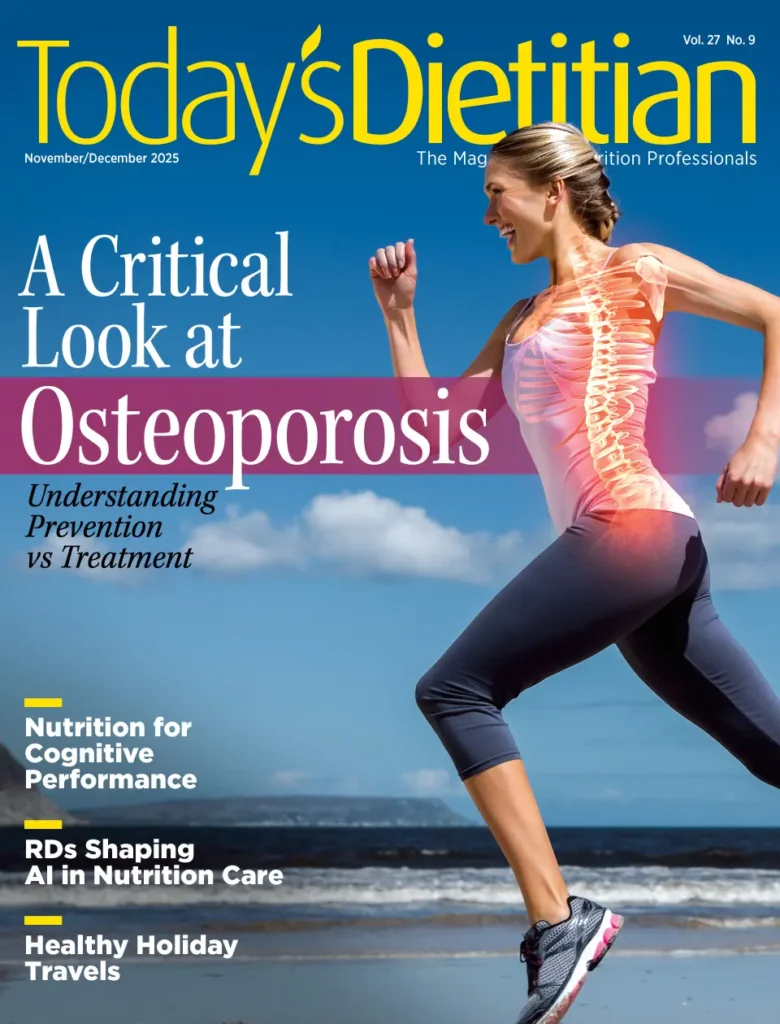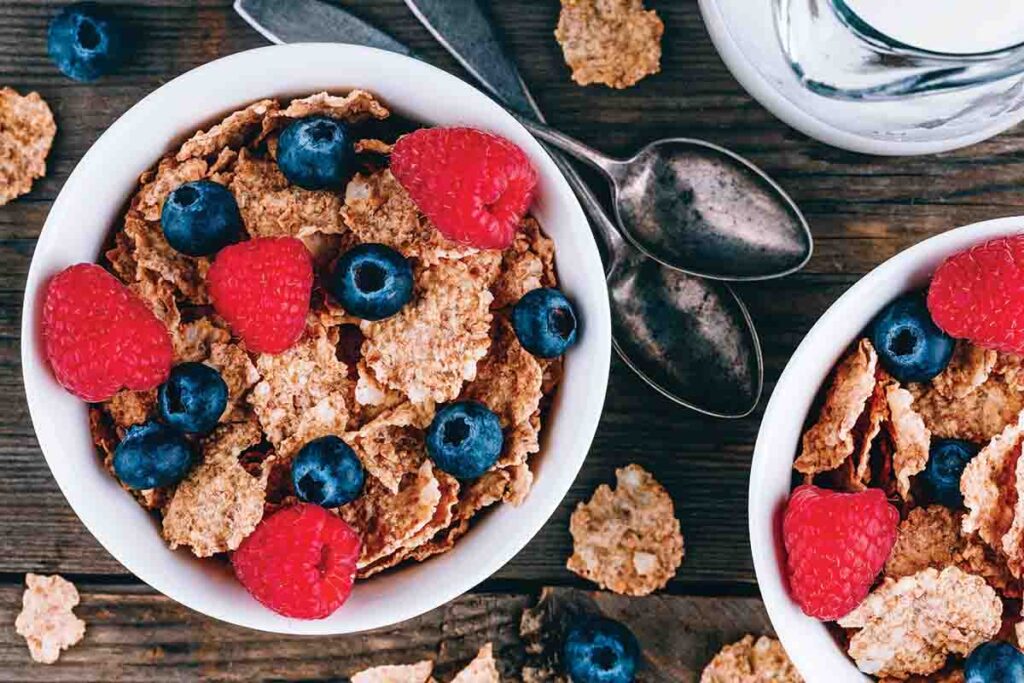Today’s Dietitian
Vol. 24, No. 6, P. 12
It’s not news that dietary fiber is a critical component of a healthful diet and that most Americans don’t consume nearly enough. In fact, the majority of Americans fall significantly short of the recommendation to consume 25 g a day (for women) and 38 g a day (for men), which roughly comes out to a recommended 14 g fiber for every 1,000 kcal consumed. However, national consumption surveys indicate that only about 5% to 9% of the population meets those recommendations. Fiber is identified as a “dietary component of public health concern” in the 2020–2025 Dietary Guidelines for Americans.1-3
Study after study has suggested an association between fiber intake and a reduced risk of some types of cancer, an improvement in glucose concentrations in people with diabetes, decreased constipation, lower blood cholesterol levels, and increased satiety, which may help with weight management.4 The question of which source of fiber might be best for the prevention of specific conditions has been far less studied. A recent study published in JAMA Network Open attempted to answer that question for CVD, with some interesting results.
The Study
Researchers from Columbia University Mailman School of Public Health in New York, University of Washington in Seattle, Harvard T.H. Chan School of Public Health in Boston, and other institutions used data from 4,125 adults, a subset of participants in the Cardiovascular Health Study (CHS), to evaluate the effects of total fiber intake and different fiber sources (cereal, vegetable, and fruit) on CVD risk. CHS was a National Institutes of Health–funded observational study that ran 1989–1999 to examine risk factors for CVD in adults aged 65 and older. An assessment of long-term usual dietary intake was done at the beginning of the study, using the National Cancer Institute’s food frequency questionnaire. Follow-up visits were conducted every six months, either in person or by phone. Blood biomarkers of inflammation, including C-reactive protein and several interleukins, were analyzed.
Low-grade systemic inflammation has been linked to an increased risk of CVD, and several previous studies have shown a positive association between these and other inflammatory biomarkers and CVD development.5,6 To analyze the possible connection between fiber intake, fiber source, and CVD, the researchers recorded stroke, myocardial infarction, or atherosclerotic cardiovascular death and the levels of inflammation biomarkers in the blood and associated those incidences with fiber intakes.
The Findings
The researchers found an association between higher total fiber intake and lower levels of inflammatory markers and reduced risk of developing CVD during the study period. One of the most interesting findings was that the association was mostly due to the consumption of cereal fiber. While the specific types of cereal fiber weren’t analyzed, according to Rupak Shivakoti, PhD, MSPH, an assistant professor of epidemiology at Columbia’s Mailman School and lead author of the study, “In an earlier study from this same cohort and dataset, the main foods contributing to cereal fiber in this study population were dark breads (whole wheat, rye, or pumpernickel) as well as high-fiber or bran cereals.” And, he added, “The dark breads, more than the others, were associated with reduced risk of CVD.”
The study also suggested that the decreased risk of CVD may not be due solely to a decrease in inflammation biomarkers. They found that one biomarker of inflammation (soluble CD163) increased with high intake of total fiber, but not with high intake of cereal fiber, so reaping fiber’s benefits might be as simple as replacing one fiber source for another. The authors suggested that other possible mediators of CVD risk due to fiber intake could be via improvements in glucose metabolism, blood lipid levels, and changes in the gut microbiome and the resulting metabolites.
Recommendations
Shivakoti says not to advise patients to change their diets based on the recent study alone, as it’s only one study and was conducted solely in older adults. “The only recommendation I have, based on national guidelines rather than the findings from this study, would be to consume sufficient levels of fiber.” In addition, he says, “that source of fiber (cereal, fruit, or vegetable) shouldn’t be changed just based on this study. Fruits and vegetables have other known benefits, regardless of their impact on inflammation or CVD.”
Angel Planells, MS, RDN, FAND, a Seattle-based dietitian and national spokesperson for the Academy of Nutrition and Dietetics, agrees. “I wouldn’t necessarily change my approach with clients, but I would say that cereal is another great option in the arsenal that we have as RDNs to promote fiber intake. Cereal is something many people might overlook due to the processed [low-fiber] versions that many people typically associate with cereals.”
Bottom Line
While this study was conducted in an older population, Shivakoti emphasizes that another study related to cereal fiber and inflammation in women aged 30 to 55 with diabetes found similar results. “We would hypothesize that the findings would hold for a younger population.” But, he adds, “this will need to be studied.”
Planells says that regardless of a client’s health status, fiber intake almost always can improve and provide a wide range of potential health benefits. He offers a reminder to advise clients who want to increase their fiber content to start slowly with small increases. And “adequate hydration and a gradual increase in physical activity can help with the processing of additional fiber.”
— Densie Webb, PhD, RD, is a freelance writer, editor, and industry consultant based in Austin, Texas.
References
1. US Department of Agriculture; Health and Human Services. Dietary Guidelines for Americans 2020–2025. https://www.dietaryguidelines.gov/sites/default/files/2020-12/Dietary_Guidelines_for_Americans_2020-2025.pdf. Published December 2020.
2. Quagliani D, Felt-Gunderson P. Closing America’s fiber intake gap: communication strategies from a food and fiber summit. Am J Lifestyle Med. 2017;11(1):80-85.
3. Miketinas D, Tucker W, Patterson M, Douglas C. Usual dietary fiber intake in US adults with diabetes: NHANES 2013–2018. Curr Dev Nutr. 2021;5(Suppl_2):1061.
4. Veronese N, Solmi M, Caruso MG, et al. Dietary fiber and health outcomes: an umbrella review of systematic reviews and meta-analyses. Am J Clin Nutr. 2018;107(3):436-444.
5. Van’t Klooster CC, Ridker PM, Hjortnaes J, et al. The relation between systemic inflammation and incident cancer in patients with stable cardiovascular disease: a cohort study. Eur Heart J. 2019;40(48):3901-3909.
6. Ridker PM, Everett BM, Thuren T, MacFadyen JG, hang WH, et al. Anti-inflammatory therapy with canakinumab for atherosclerotic disease. N Engl J Med. 2017;377(12):1119-1131.



